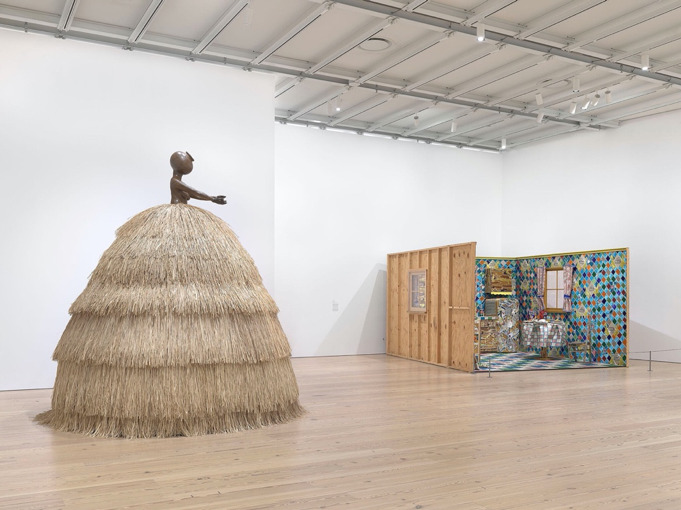
“Making Knowing: Craft in Art, 1950-2019” at the Whitney Museum of American Art
Nov 22, 2019 – Feb, 2022
All images courtesy of the Whitney Museum of American Art
“Making Knowing: Craft in Art, 1950-2019” is currently on view at the Whitney Museum of American Art and includes works of sixty artists selected from the museum’s collection to chronologically show how craft techniques traditionally associated with mostly ‘feminine’ pastime have been integrated into the contemporary art. Curated by Elisabeth Sherman and Jessica Goldstein this immersive exhibition comes across as a successful attempt to represent distinct artistic investigations in the mediums of embroidery, weaving, glassmaking, sewing, ironwork, beading, pottery and revisit them as yet another way to create objects of beauty or consequence. Since the time of the Renaissance art guilds art always had craft components to it, ever, yet segmentation of artists into professionals and amateurs somehow pushed craft towards being the occupation of the less serious half. Contemporary art became more conceptually driven, well-crafted objects becoming markers of the past or so it seems.

This show clearly and cohesively fights this stereotype. First, it provides a wide representation of artists, covering many ethnic backgrounds and various types of craft as integral to visual language and symbology, across genres and generations. Presented objects by Robert Rauschenberg, Eva Hesse, Agnes Martin, Howardina Pindell among many others underline the fact artists who are habitually associated with the New York school, postminimalism, abstract expressionism, or second wave of feminism all used craft to achieve their very concrete tasks without ever labeling themselves as ‘craftsmen’ or ‘craftswomen.’ One notable exception on view would be outstanding African-American artist Rosie Lee Thompkins who is chiefly known for her majestic multicolored quilts striking with their ingenuity and complexity. But even in Thompkins’ case, the quilts were used as means rather than ends, she created objects to engage with the themes she was interested in, quilts being her canvases.

Second, the gender factor is important here. The exhibition presents the work of sixty artists half of whom are men and half of them women. By making this selection curators addressed traditional gender identity. Martin Puryear, who represented the United States at the Venice Biennale in 2019 is shown with a simple and elegant sculptural piece made from stainless steel, emphasizing his ongoing engagement with traditions of carving and boat-building, the stereotypical gendered image of a man with capable hands. Puryear is contrasted with Nick Cave’s multicolored Sound Suit#20 painstakingly made from thousands of beads, a medium traditionally allocated to women across various cultures. Ruth Asawa’s organic forms constructed from looped wire, a craft connected to fishermen nets is displayed next to Lenore G. Tawney’s work “Four Petal Flower II.” Tawney deconstructed the traditional way of weaving to arrive at the novel shape of the tapestry on view, yet she used a loom in doing so.

Finally, the narrative structure of this exhibition built chronologically from the 1950s to 2000 gives a visitor an ample opportunity to see how indeed something associated with women, domesticity, home, and availability of time at hand has over time transformed into a unique, conceptual way of engaging with ideas of race, identity, history, tradition, labor, and contemporaneity. The exhibition starts with more traditionally looking weaved patterns by Sheila Hicks and Alice Adams and concludes with Liza Lou’s “The Kitchen,” a room fully rendered using multicolored beads for all the surfaces, including pots, floors, sink, dishes, as well as germs on those dishes. Lou worked five years on this piece and for her, it is a contemporary statement about the traditional role of women, sexism, and emancipation rendered in beads. A circle is complete.

Video walk-through of “Making Knowing: Craft in Art, 1950-2019” at the Whitney Museum of American Art
